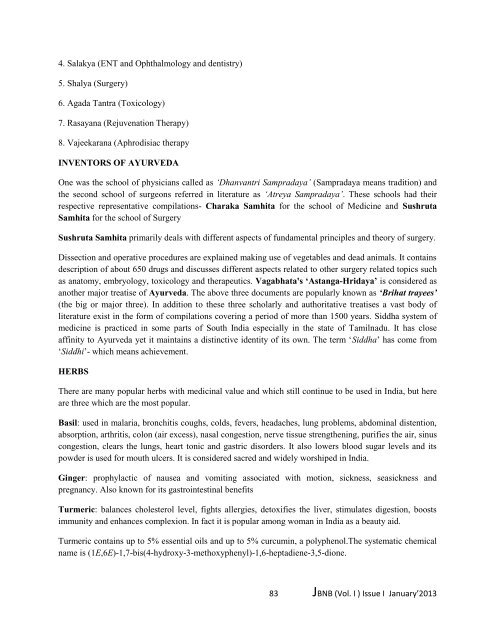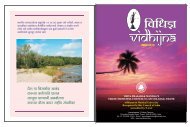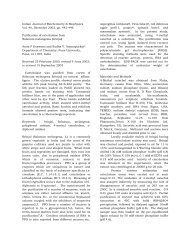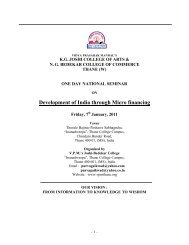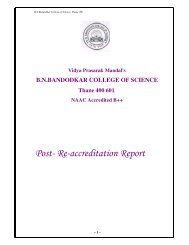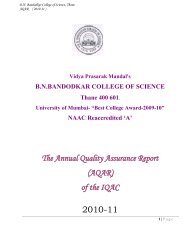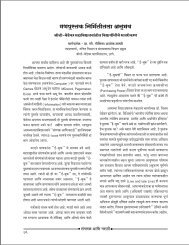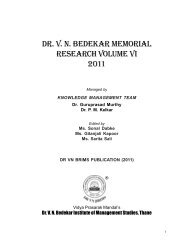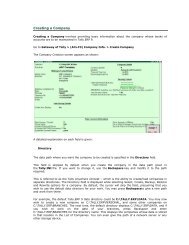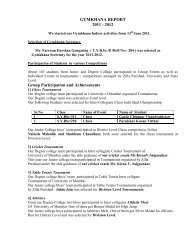J-BNB - VPMThane.org
J-BNB - VPMThane.org
J-BNB - VPMThane.org
Create successful ePaper yourself
Turn your PDF publications into a flip-book with our unique Google optimized e-Paper software.
4. Salakya (ENT and Ophthalmology and dentistry)<br />
5. Shalya (Surgery)<br />
6. Agada Tantra (Toxicology)<br />
7. Rasayana (Rejuvenation Therapy)<br />
8. Vajeekarana (Aphrodisiac therapy<br />
INVENTORS OF AYURVEDA<br />
One was the school of physicians called as ‘Dhanvantri Sampradaya’ (Sampradaya means tradition) and<br />
the second school of surgeons referred in literature as ‘Atreya Sampradaya’. These schools had their<br />
respective representative compilations- Charaka Samhita for the school of Medicine and Sushruta<br />
Samhita for the school of Surgery<br />
Sushruta Samhita primarily deals with different aspects of fundamental principles and theory of surgery.<br />
Dissection and operative procedures are explained making use of vegetables and dead animals. It contains<br />
description of about 650 drugs and discusses different aspects related to other surgery related topics such<br />
as anatomy, embryology, toxicology and therapeutics. Vagabhata's „Astanga-Hridaya‟ is considered as<br />
another major treatise of Ayurveda. The above three documents are popularly known as ‘Brihat trayees’<br />
(the big or major three). In addition to these three scholarly and authoritative treatises a vast body of<br />
literature exist in the form of compilations covering a period of more than 1500 years. Siddha system of<br />
medicine is practiced in some parts of South India especially in the state of Tamilnadu. It has close<br />
affinity to Ayurveda yet it maintains a distinctive identity of its own. The term ‗Siddha‘ has come from<br />
‗Siddhi‘- which means achievement.<br />
HERBS<br />
There are many popular herbs with medicinal value and which still continue to be used in India, but here<br />
are three which are the most popular.<br />
Basil: used in malaria, bronchitis coughs, colds, fevers, headaches, lung problems, abdominal distention,<br />
absorption, arthritis, colon (air excess), nasal congestion, nerve tissue strengthening, purifies the air, sinus<br />
congestion, clears the lungs, heart tonic and gastric disorders. It also lowers blood sugar levels and its<br />
powder is used for mouth ulcers. It is considered sacred and widely worshiped in India.<br />
Ginger: prophylactic of nausea and vomiting associated with motion, sickness, seasickness and<br />
pregnancy. Also known for its gastrointestinal benefits<br />
Turmeric: balances cholesterol level, fights allergies, detoxifies the liver, stimulates digestion, boosts<br />
immunity and enhances complexion. In fact it is popular among woman in India as a beauty aid.<br />
Turmeric contains up to 5% essential oils and up to 5% curcumin, a polyphenol.The systematic chemical<br />
name is (1E,6E)-1,7-bis(4-hydroxy-3-methoxyphenyl)-1,6-heptadiene-3,5-dione.<br />
83 J<strong>BNB</strong> (Vol. I ) Issue I January’2013


